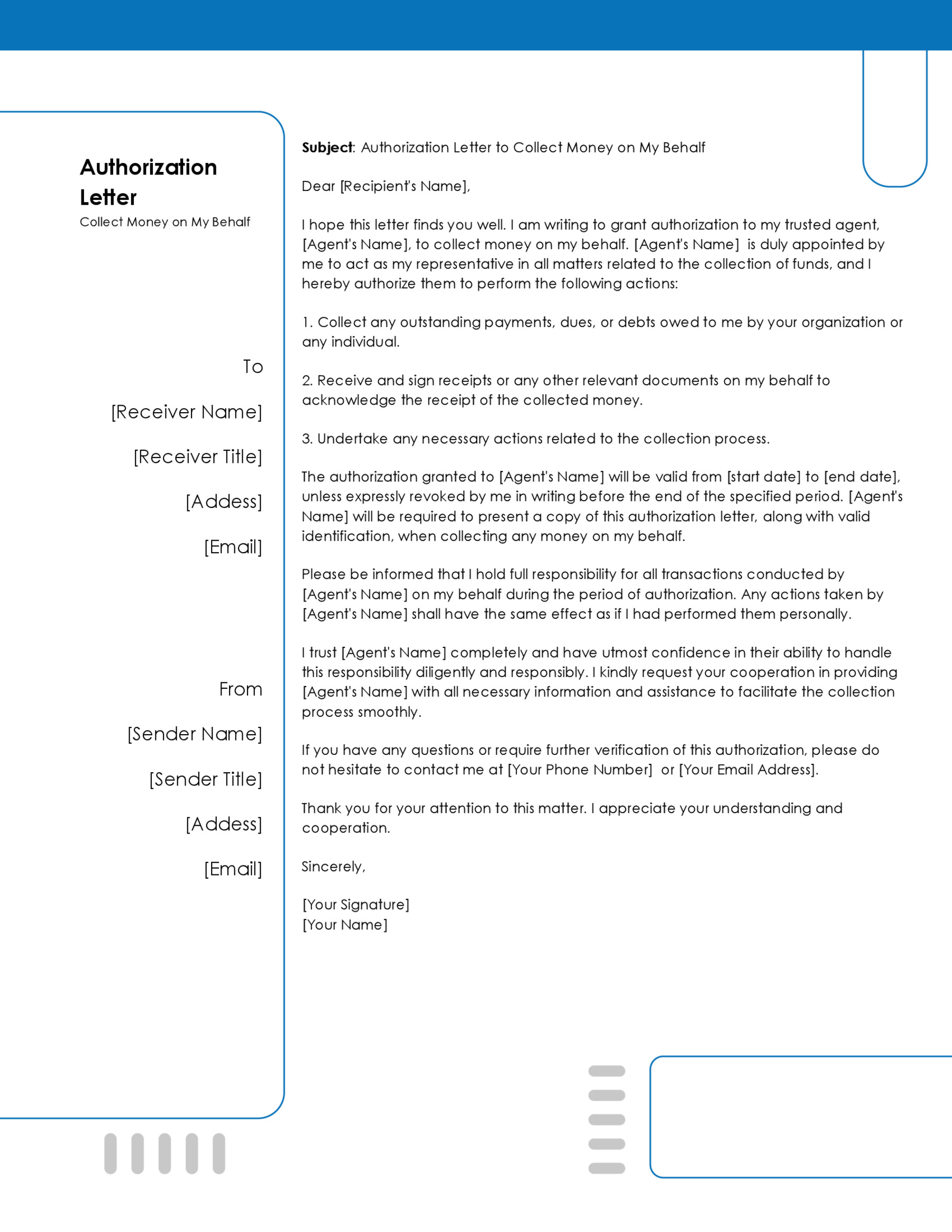A reference/recommendation letter for an employee is a document written by a qualified, trustworthy person that aims to endorse a candidate for a given job position.
The letter highlights the employee’s skills, desirable attributes, achievements, and any relevant work experiences. A letter of recommendation for an employee should be written by someone who knows the candidate well enough and can speak positively about the applicant. In addition, he/she must be competent and reliable, meaning that he/she must have an official, recognized role within the field related to the applicant’s position.
Since the main point of the letter is to make the case that the applicant is a strong candidate and that they will be successful in the prospective position, the best person to write the letter is usually the employee’s current or former employer, supervisor, and team leader.
However, in some cases, the letter can be written by the employee’s coworkers. If the applicant is a recent graduate with no relevant work experience, a professor, friend, neighbor, or any other personal contact might be qualified to write the letter.
Free Templates
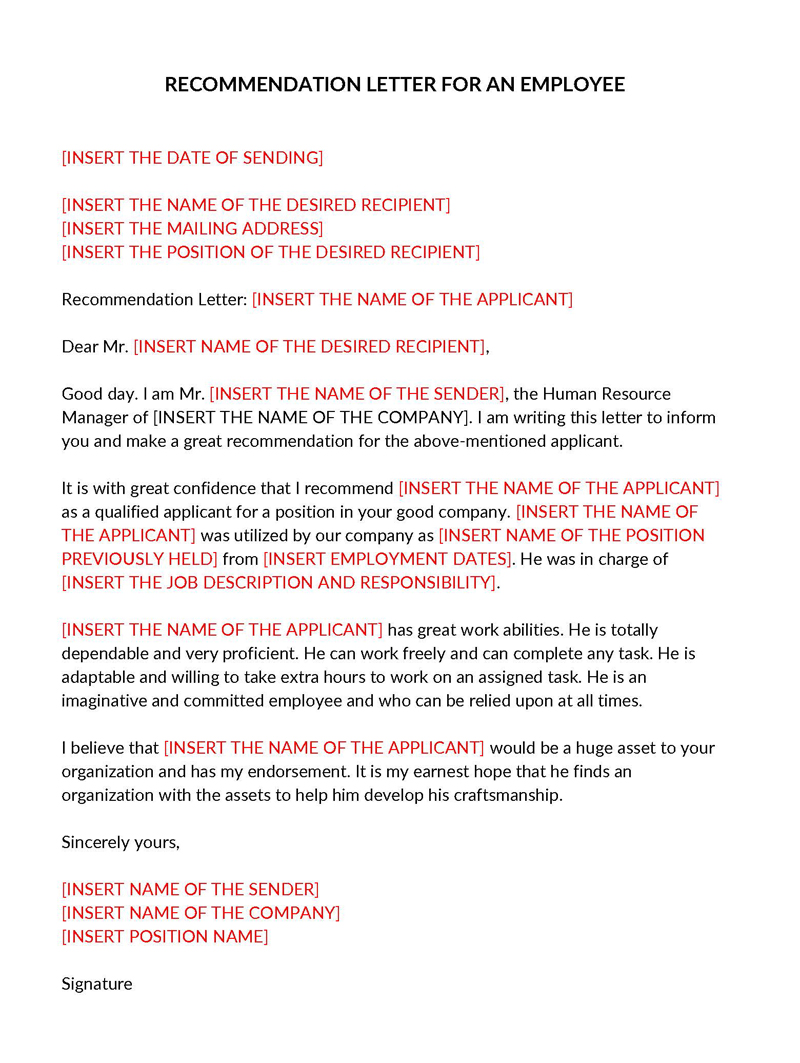
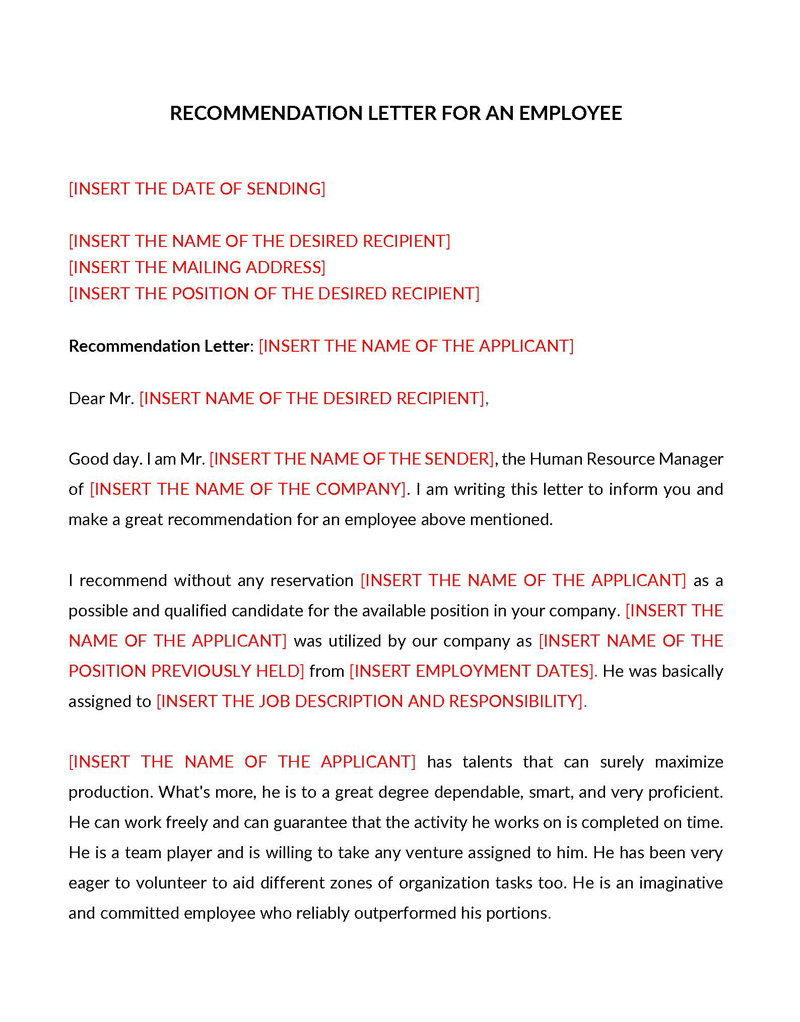



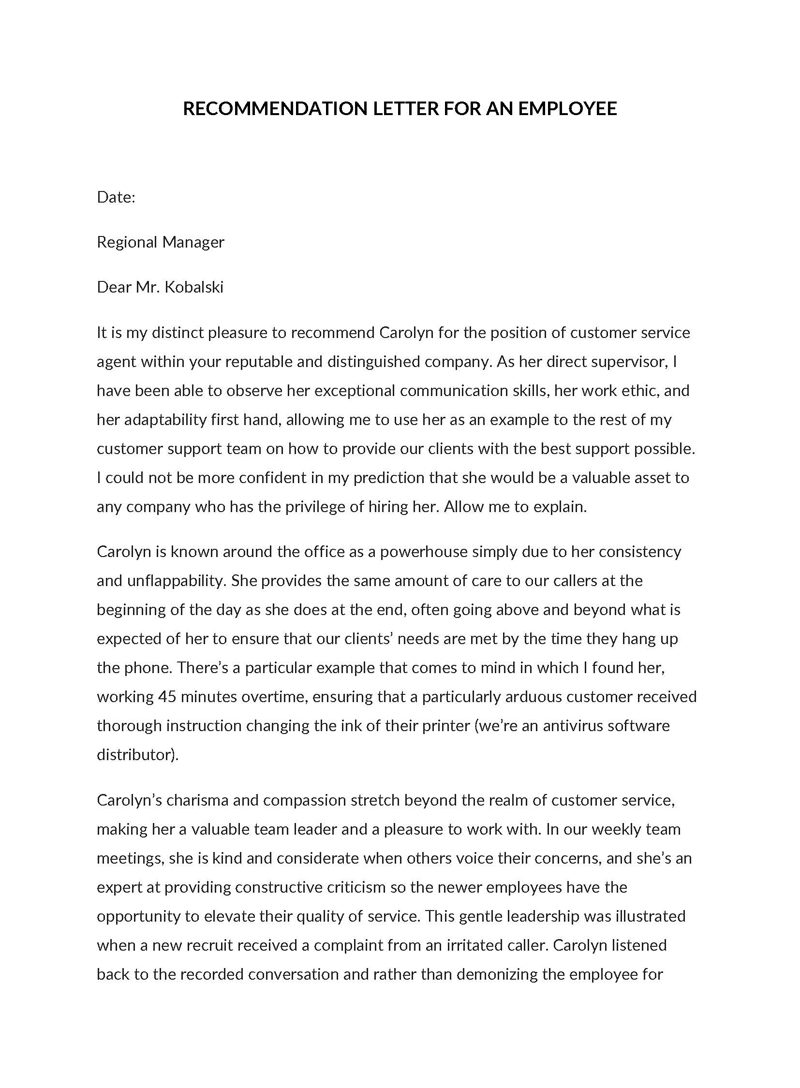
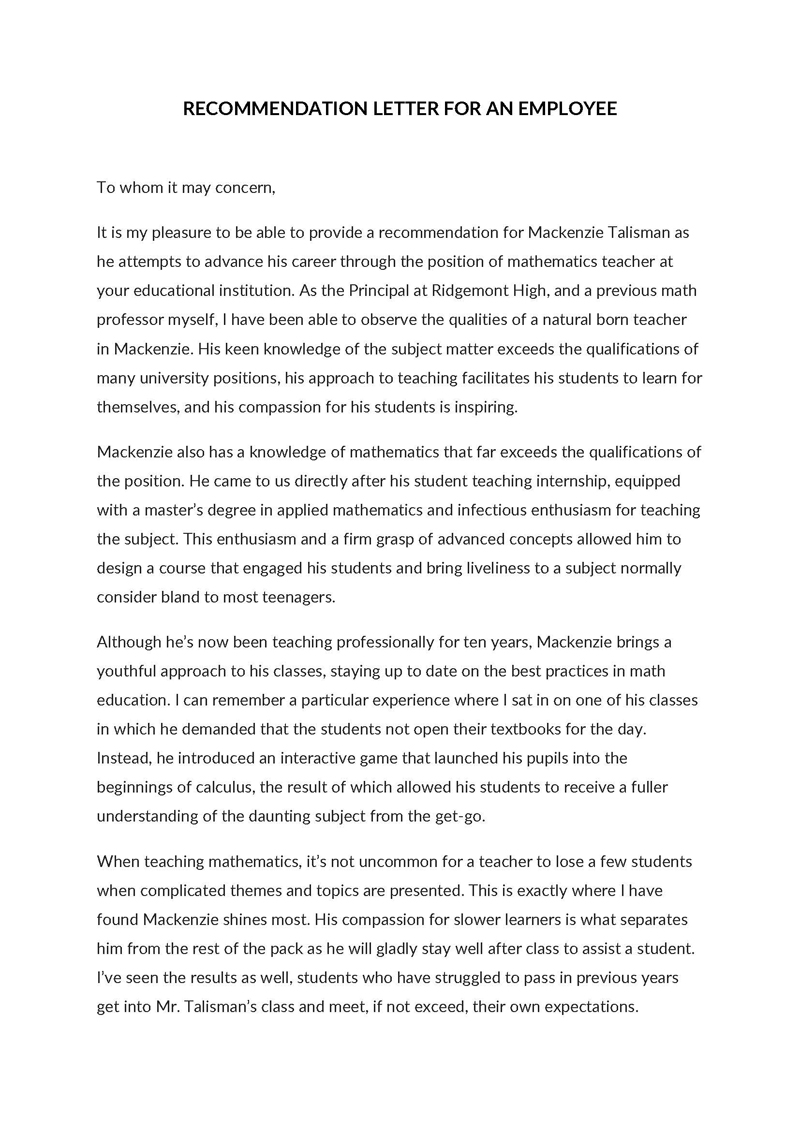
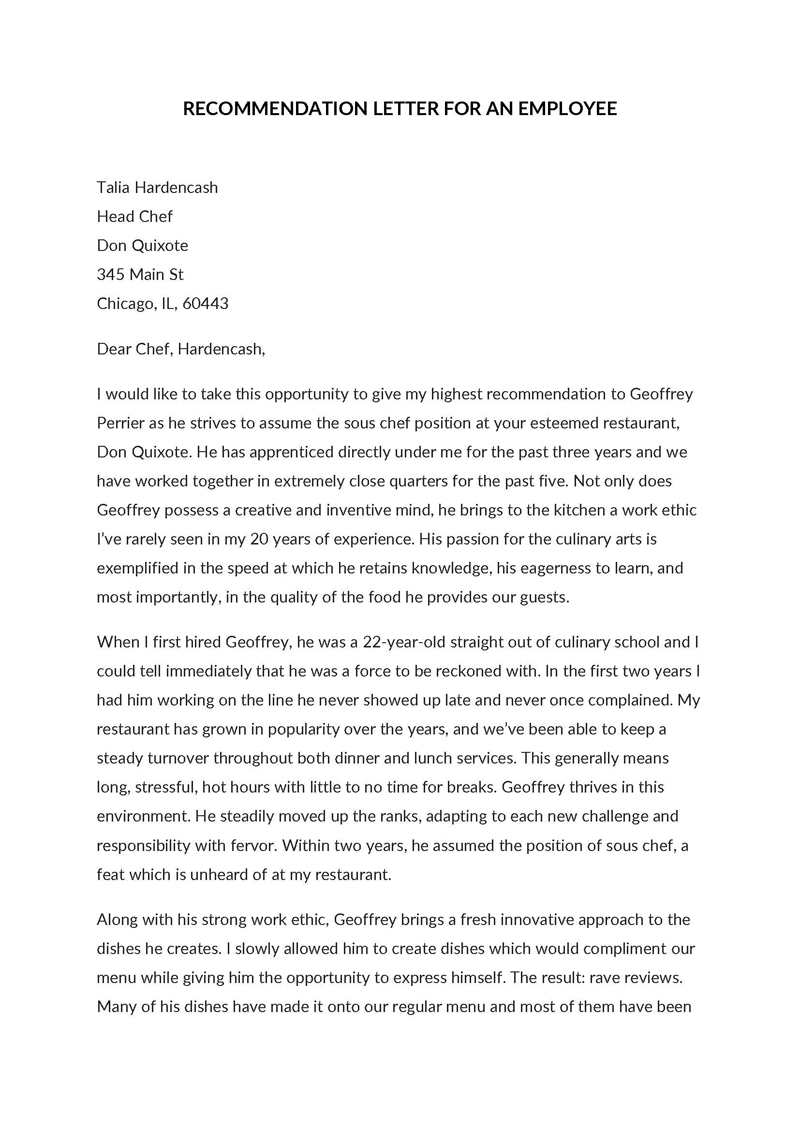
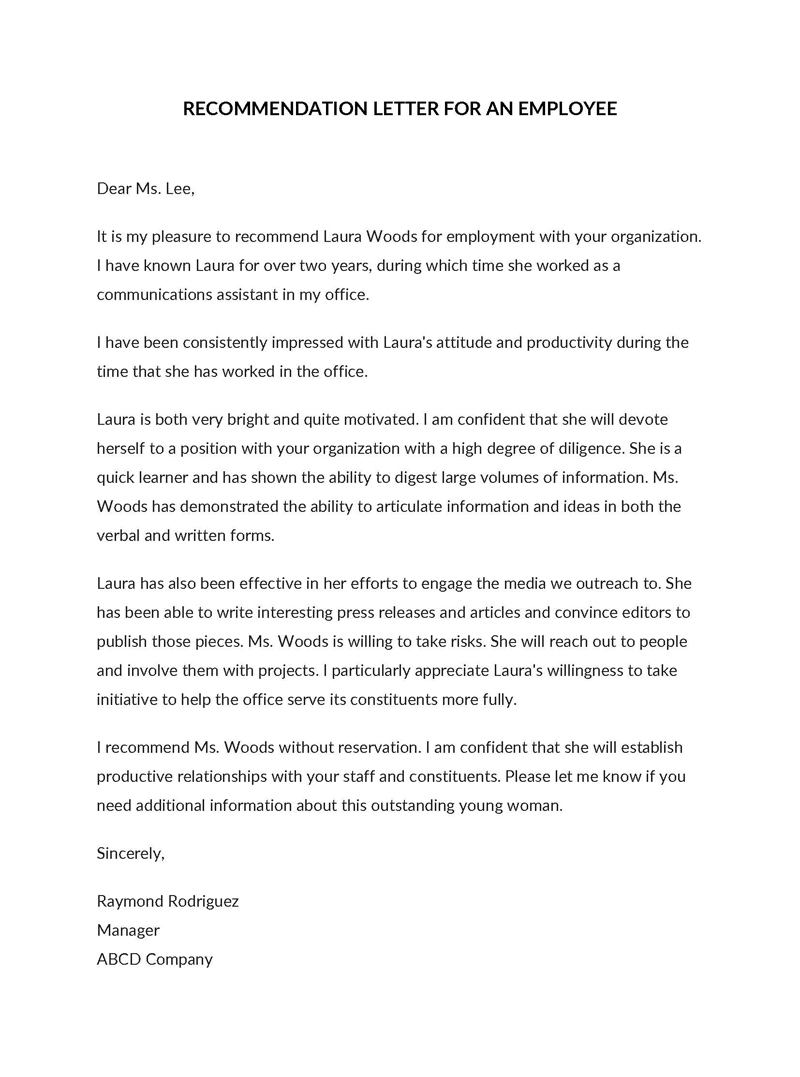

Pre-Writing Considerations
If you are an employer, a supervisor, a team leader, or a coworker, you might be approached by an employee requesting that you write them a recommendation letter to help them get a potential job.
Before you agree to write the letter, you must consider the following pre-writing things:
Think carefully before accepting the offer
Before accepting to write an employee recommendation letter, make sure that you can provide a positive and enthusiastic recommendation for the employee.
Ask yourself the following questions:
- How well do you know the candidate?
- Do you have enough specific examples and anecdotes to write in the letter?
- Why are you recommending the employee?
- Do you believe in them to vouch for their candidacy?
If you can comfortably answer all these questions, you can accept the offer and write a strong recommendation letter for the employee. However, if you feel you lack enough answers to these questions, you don’t know of any positive things to say about the employee, or if your company has a policy that prohibits providing references for employees, it’s best to decline the request politely. Remember that it is better not to write a recommendation at all than to write something less than a strong endorsement of the applicant’s candidacy.
Collect information before writing the letter
Next, ask the employee to provide you with enough information about the job they are applying for and request a copy of their curriculum vitae or resume to highlight their specific work experience and desirable qualities for the job. It is also essential to view the employee’s social media profiles, such as LinkedIn, to gather information and supporting pieces of evidence to help you write a strong recommendation letter.
How to Write
An effective letter for an employee should make the applicant stand out from the other highly competitive applicants. To achieve this, you have to inspire reliability and trustworthiness in the hiring team.
Here is a step-by-step guide on how to structure your employee letter of recommendation:
Section 1: Letterhead
A letter for an employee is an official letter. Therefore, it should follow the business letter format of addressing an official letter. As such, at the topmost part of the letter, you should include an address that consists of the following details:
Your contact information
In the sender’s address line, write your name and provide your contact information, including your email and mailing addresses.
Subject line (email reference)
If the employee’s recommendation letter is to be submitted online via email, then, in that case, you should follow the business letter format but omit the address paragraphs. You should include a subject line that includes the applicant’s name and the title of the position they are applying for.
EXAMPLE
Subject: Maryann Kimm- Recommendation for Public Relations Manager Job
note
In the case of an email employee’s reference letter, the sender’s contact information list is usually provided in the signature section.
Date
After writing your address, write the date on which you are writing the letter. The date should follow the Day/Month/year format.
Recipient’s contact details
In the receiver’s address paragraphs, write the recipient’s name (if known) and provide their contact details, including the company name, email, and mailing address.
Salutation
Begin the letter with a formal salutation and greeting addressed to the letter’s receiver if he/she is known, or in cases where you are writing a personal reference letter.
EXAMPLE
Dear Mr. Lawrence, Dear Ms. Watkins, etc.
However, if the receiver’s name is unknown or in cases where you are writing a general reference letter, a general salutation such as To Whom It May Concern, Dear Hiring Team, To the HR Department, etc., may be considered appropriate; alternatively, you can omit the salutation part and start with the introduction of the letter.
Section 2: Introduction
In the introductory paragraph of the letter, briefly introduce yourself and state why you are competent to provide a reference letter for the specific employee. Include your current job title or the position you hold in your company. Afterward, write the name of the employee you are vouching for and describe the nature of your relationship.
EXAMPLE
I am delighted and greatly honored to provide this letter of recommendation for Maryann Kimm. As an overall team leader at Medicentre Modern Care Hospital, I have worked with and supervised Maryann Kimm for the past 6 years. In all these years, I have been able to test and appreciate her professional qualities in various circumstances, and I am confident that she will be an invaluable asset to your company.
Section 3: Body
Generally, the body section of the letter will be subdivided into two main body paragraphs that illustrate why the applicant is ideal for the job. This includes:
Elaborate the applicant’s skills, strengths, and experience
Use the first body paragraph of your recommendation letter for an employee to evaluate the applicant’s work, focusing on their specific skills, strengths, and experience and relating them to the position they are seeking.
EXAMPLE
If the applicant is seeking a public relations management position, showcase his/her excellent communication, interpersonal, presentation, creativity, and awareness skills. Make sure to also highlight any relevant, tangible successes that can be quantified to help justify your case.
Give examples of the applicant’s achievements
The second body paragraph of your letter for an employee should highlight specific examples of the applicant’s achievements. In 3-5 brief lines, describe how the applicant stood out from the rest of his/her colleagues and use specific examples that prove your case. Whether it is taking the initiative on a particular project or helping solve a major company-wide problem, concrete anecdotes relevant to the applicant’s position help create a lasting impression on potential employers.
However, if you cannot provide specific examples and anecdotes that demonstrate the applicant’s various skills and achievements, you can use the comparison strategy to make them stand out from the pool of other qualified candidates.
EXAMPLE
You can state that:
Maryann is among the top 3 best PR officers that I have ever worked with.
Section 4: Conclusion
It is essential that you conclude your letter enthusiastically and professionally such that the employer is convinced to hire the applicant instantly. Here are some tips to help you conclude your letter strongly:
Restate your recommendation
Provide a brief summary of the main attributes, strengths, and skills discussed in the body paragraphs and restate why you are recommending the applicant.
Provide your contact details for follow-up
Afterward, provide your contact details, including your email address and phone number, to make it easier for the recipient of the letter to contact you if they need more information. To make the letter seem more professional and to influence how the recipient perceives it, it is crucial that you provide your company’s official email address rather than your personal email address.
Sign off
Finally, end your letter with an appropriate sign-off, then include your name and signature.
Tips for Writing an Effective Recommendation Letter
If you are looking to write a strong recommendation letter, consider the following tips to help you craft a letter that will make the applicant stand out and help them secure the job:
Focus on the job description
Request that the applicant provide you with a copy of the job description review it to find the precise skills, qualifications, and experience that the employer is looking for, and tailor your letter to meet the criteria specified in the job description.
Stay Positive
A recommendation letter should emphasize how the employee is a good fit for the position, and therefore the language used throughout the letter should remain positive. This helps the applicant stand out and influences the employer’s decision to hire him/her. However, you should be careful not to provide any falsified information, as this could be very damaging for both you and the applicant in the future.
Follow the submission guidelines
Aside from information about the applicant and the job they are seeking, you will also need to get accurate details on the submission guidelines. Confirm whom to address the letter to, when the deadline is, if there is a specific format to follow, and if the letter is to be submitted online or in hard copy. Make sure to follow the submission guidelines to the latter to ensure that your letter reaches its intended audience.
Letter Template
Review the following template and use it as a reference to write your own letter of recommendation. Alternatively, you can personalize this template and include the specific information that suits the person you recommend, making your letter unique and customized for the job.
Template
[RECOMMENDER’S NAME]
[RECOMMENDER’S POSITION]
[OFFICIAL BUSINESS ADDRESS]
[CURRENT DATE]
[RECEIVER’S NAME]
[COMPANY NAME]
[ADDRESS]
Dear_____________ [receiver’s name]/ To Whom it may Concern,
I am delighted to recommend_________ [applicant’s name] for_______________ [applicant’s target position] at your company. [Applicant’s name] has worked with us at____________ [your company’s name] as a_____________ [Applicant’s former or current job title] for__________ [Mention the duration] and he/she has been reporting to me in my position as the overall department supervisor.
Ever since he/she joined this company, he/she has proved to be an invaluable asset to the organization, and she has played a key role in helping this company achieve most of its key goals. [Applicant’s name] is an excellent communicator (both verbally and in writing), is extremely organized, and can work under minimum supervision. Beyond that, ___ [applicant’s name] is honest, dependable, hardworking, and can take the initiative to complete even the most complex of tasks, and this makes it pleasurable to work around her. Everyone in the company adores how_____________ [applicant’s name] is able to draw inspiration from any challenge that he/she faces, rather than being intimidated by them.
At one point, _[applicant’s name] professional etiquette and expertise in problem-solving proved to be pivotal in solving a consumer complaint issue for our entire company. Not only did [he/she] put this skillset to work, but [he/she] also led a campaign to help redeem our company’s reputation. Moreover, she spearheaded a series of training sessions to educate the rest of the team on handling consumer complaint issues to achieve customer satisfaction. This helped increase our overall sales by 30% and our profit margins by 18%.
Along with ___ [applicant’s name] undeniable talent, he/she has always been a great team player, always fostering discipline and positive discussions to help bring the best out of everyone. Given the above-mentioned reasons and countless other reasons, I strongly recommend___________ [applicant’s name]to join your company. Frankly, I wouldn’t have let him/her resign from her current position if my company was able to offer her the career fulfillment goals that he/she is hoping to get from your company. I hope that you consider him/her for the job.
I would be happy to offer any further information that you may need concerning_________ [applicant’s name] qualifications. Feel free to contact me at_______________ [Provide your reliable phone number or email address].
Sincerely,
[RECOMMENDER’S NAME AND JOB TITLE]
[SIGNATURE]
Sample Letter
In this section, you’ll find a free sample recommendation letter for former employees, serving as a resource for employers navigating the process of endorsing past team members.
sample
To Whom It May Concern,
I am writing to wholeheartedly recommend John Smith for any position he chooses to pursue. As John’s supervisor during his tenure at Tech Innovations, I had the pleasure of witnessing his remarkable skills and unwavering commitment firsthand. John joined our team as a Software Engineer and quickly distinguished himself with his technical acumen, innovative thinking, and collaborative work ethic.
John played a pivotal role in several key projects, including the development of our award-winning mobile application. His ability to translate complex requirements into efficient, user-friendly solutions was truly exceptional. Beyond his technical prowess, John’s positive attitude and ability to inspire his colleagues set him apart. He was always willing to go the extra mile to ensure project success, offering insightful feedback and support to his team members.
What impressed me most about John was his continuous drive for self-improvement and professional growth. He consistently sought out new challenges and was proactive in acquiring new skills. His contributions extended beyond his job description; he volunteered to lead several team-building activities and played a key role in streamlining our software development process, significantly enhancing our team’s efficiency and output.
In summary, John is a dedicated and highly skilled professional with a commendable work ethic. His departure was a significant loss to our team, but I have no doubt that he will bring the same level of excellence and dedication to his future endeavors. I strongly recommend him for any position he seeks, as he will be a valuable asset to any organization.
Sincerely,
Michael Cole
Analysis
The provided recommendation letter serves as a useful guide for crafting a professional and effective endorsement of a former employee. Its strengths lie in its clear structure, comprehensive content, and adherence to the conventions of professional communication.
Firstly, the letter follows a well-organized four-paragraph structure, which is beneficial for conveying information in a logical and coherent manner. The introductory paragraph establishes the writer’s intent to recommend the employee, which immediately informs the reader of the letter’s purpose. This direct approach is efficient and respects the reader’s time.
Secondly, the content of the letter is both comprehensive and specific. It avoids vague praises and instead provides concrete examples of the employee’s achievements and skills. This specificity adds credibility to the recommendation and gives the prospective employer a clear understanding of the employee’s capabilities. Moreover, the inclusion of soft skills, like leadership and mentorship, alongside technical achievements creates a well-rounded portrait of the employee, demonstrating her value beyond mere technical competence.
Thirdly, the letter exemplifies professionalism in its tone and language. It maintains a formal tone throughout, which is appropriate for a professional recommendation. The language is respectful and positive but avoids hyperbole, thus striking a balance between enthusiasm and credibility.
Finally, the concluding paragraph reiterates the endorsement and provides the writer’s contact information, inviting further inquiries. This shows openness and confidence in the employee’s abilities, reinforcing the letter’s purpose.
In summary, the letter is a commendable example for those seeking to write a professional recommendation. Its clarity, specificity, formal tone, and comprehensive content align with the requirements of a good professional letter, making it an effective tool for endorsing a former employee’s skills and contributions.
Final Thoughts
Writing a recommendation letter for an employee to endorse them for a particular job is a significant undertaking, and recommenders should take their time to understand the elements needed to craft an effective one fully. Whereas the specifics of the letter may vary, strong letters tend to share certain common features, such as the general structure of writing and formatting tips. This article has provided you with detailed guidelines for writing an effective reference letter and essential tips for writing an effective recommendation letter.











